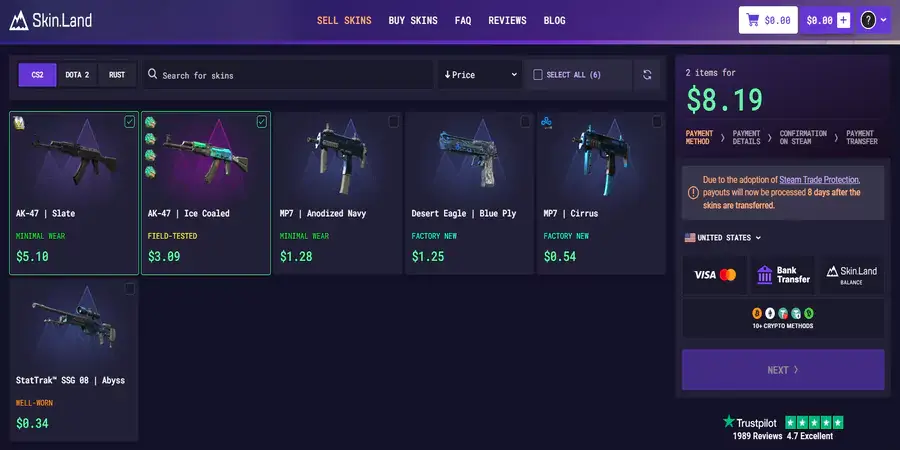For years, the Steam Marketplace has been the place for trading CS:GO and now CS2 skins. With just a few clicks, players could buy, sell, and flaunt their skins. However, as the skin economy exploded, generating millions of dollars and attracting investors, collectors, and full-time traders, Steam’s tightly controlled ecosystem began to show its cracks. High fees, limited cash-out options, and a lack of trading freedom left many users searching for alternatives.
Enter platforms like Skin.Land. It’s a third-party marketplace offering better prices, real-money transactions, and a decentralized approach to skin trading. These platforms are redefining how players interact with their inventories, moving away from Valve’s walled garden and toward a more open and flexible economy.
In this article, we’ll explore why CS2 skins markets are gaining traction, how they work, and why they might just be the future of digital asset trading in gaming.
Steam is the only marketplace for skins
For a long time, Steam was the only platform for trading and selling CS skins simply because Valve owned them. Skins are digital items tied to Steam accounts, and Valve tightly controlled how those items could be moved, sold, or traded. The Steam Marketplace was the official, built-in solution.
In the early years, there were few alternatives. Valve restricted third-party access to its trading APIs, and using external platforms posed serious risks: scams, fraud, or even VAC bans if you broke Steam’s rules. Plus, most casual players didn’t need more than what Steam offered – a few skins, a place to sell them, and store credit to spend on other games.
But as skin values skyrocketed and the trading scene became more competitive, Steam’s limitations became bottlenecks. The lack of real cash withdrawals, high fees, and restricted freedom led power users to seek out new solutions – paving the way for decentralized marketplaces like Skin.Land to gain traction.
Rise of Third-Party Marketplaces
As the CS skin economy matured, players started demanding more than what Steam could offer. That’s when third-party marketplaces began to rise, and their popularity wasn’t just a coincidence. These platforms solved real problems that the Steam Marketplace had ignored for years.
Here is why they become more popular:
- Real Money Withdrawals
- Lower Fees
- Faster Transactions
- More Flexibility & Features
- Escape Valve’s Control
Many users also grew frustrated with Valve’s strict rules, trade bans, and lack of customer support. Third-party sites offered a way to escape that centralized control and operate more freely in a user-driven economy. They empowered users: offering better prices, more freedom, and a more flexible trading experience. Platforms like Skin.Land didn’t just copy Steam’s model; they improved it. Here is the best and safest place to sell or trade your CS2 skins.
Why Skin.Land is the best place to sell and trade skins in CS2?
Among the many skins marketplaces out there, Skin.land has quickly emerged as one of the most trusted and feature-rich platforms for CS2 skin trading, and it’s not hard to see why. It combines competitive pricing, modern design, and a smooth user experience that goes far beyond what Steam offers. Many users consider it one of the best Steam alternatives right now.
Instant Real Money Cashouts
Unlike Steam, where your funds are trapped in your wallet, Skin.land lets you sell your skins for real cash and withdraw it using popular payment methods like bank cards, crypto, or e-wallets.
Lower Fees = More Profit
Skin.Land charges significantly lower fees than Steam’s 15%, which means sellers earn more per transaction—and buyers get better deals.
Fast, Secure Transactions
With Skin.Land’s modern infrastructure, most trades are instant or near-instant, and the site uses real-time inventory syncing to ensure what you see is always up to date.
Trusted and Safe
Skin.land has built a solid reputation with active support, secure trading bots, and anti-scam measures that protect users. Verified sellers, transparent listings, and a clean user interface all contribute to a safe experience.
Smart Design, Smooth UX
The platform is fast, intuitive, and mobile-friendly. Whether you’re selling a single AK skin or managing a large inventory, Skin.land makes it easy to get the job done.
Conclusion
The days when the Steam Marketplace reigned unchallenged are over. As the CS2 skin economy continues to grow in value and complexity, players are demanding more control, better pricing, and real financial freedom. Third-party platforms like Skin.land are better than Steam. They offer instant trades, real money cashouts, lower fees, and smarter tools for sellers and buyers alike.
These decentralized marketplaces aren’t just alternatives. They’re the future of digital item trading. They’re reshaping how gamers think about skins: not just as cosmetic add-ons, but as valuable digital assets in a global economy.
Whether you’re a casual player, a serious trader, or somewhere in between, it’s time to rethink where and how you trade your skins. Skin.land isn’t just a better platform. It’s a better way to trade.













